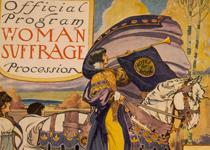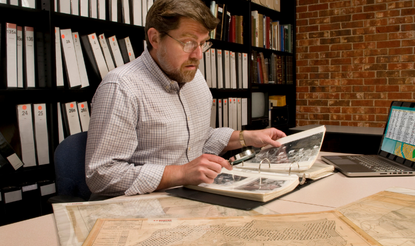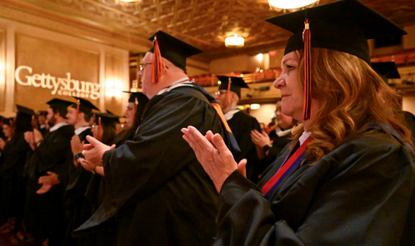Sisters of Suffrage: British and American Women Fight for the Vote
by Barbara Winslow
 The dominant narrative of the entire women’s suffrage movement begins and ends with the United States and Britain. Hundreds of thousands of women petitioned, canvassed, lobbied, demonstrated, engaged in mass civil disobedience, went to jail, and engaged in hunger strikes in a seventy-five-year ongoing political and social struggle for the right to vote. In the United States, the organized movement for women’s suffrage began in 1848, when 300 people showed up in the small, bustling town of Seneca Falls, New York, to attend the first women’s rights convention, which was organized by Elizabeth Cady Stanton, Lucretia Mott, and three other women’s rights reformers. Stanton drafted a Declaration of Sentiments for the convention, which called for, among many things, the "right [of women] to the elective franchise." Organizing for women’s suffrage was temporarily suspended as a result of the Civil War (1861–1865). After Reconstruction ended in 1876, most women’s rights energies were channeled into the struggle for suffrage. From 1876 until the beginning of the twentieth century, most suffrage organizing consisted of countless local and state campaigns, involvement in referendums, and convincing politicians to support women’s suffrage. And during those years, women won the right to vote in Wyoming, Colorado, Idaho, and Utah. The growth of urbanization and industrialization in the late nineteenth century, combined with a more restive organized labor and social reform movement, intensified the struggle for women’s suffrage. In the early years of the twentieth century, more and more states granted women’s suffrage, and the National Women’s Suffrage Association (NWSA), having just united rival suffrage organizations, pressed its claim for state and federal women’s suffrage amendments. In 1920, the Nineteenth Amendment granted women the right to vote.
The dominant narrative of the entire women’s suffrage movement begins and ends with the United States and Britain. Hundreds of thousands of women petitioned, canvassed, lobbied, demonstrated, engaged in mass civil disobedience, went to jail, and engaged in hunger strikes in a seventy-five-year ongoing political and social struggle for the right to vote. In the United States, the organized movement for women’s suffrage began in 1848, when 300 people showed up in the small, bustling town of Seneca Falls, New York, to attend the first women’s rights convention, which was organized by Elizabeth Cady Stanton, Lucretia Mott, and three other women’s rights reformers. Stanton drafted a Declaration of Sentiments for the convention, which called for, among many things, the "right [of women] to the elective franchise." Organizing for women’s suffrage was temporarily suspended as a result of the Civil War (1861–1865). After Reconstruction ended in 1876, most women’s rights energies were channeled into the struggle for suffrage. From 1876 until the beginning of the twentieth century, most suffrage organizing consisted of countless local and state campaigns, involvement in referendums, and convincing politicians to support women’s suffrage. And during those years, women won the right to vote in Wyoming, Colorado, Idaho, and Utah. The growth of urbanization and industrialization in the late nineteenth century, combined with a more restive organized labor and social reform movement, intensified the struggle for women’s suffrage. In the early years of the twentieth century, more and more states granted women’s suffrage, and the National Women’s Suffrage Association (NWSA), having just united rival suffrage organizations, pressed its claim for state and federal women’s suffrage amendments. In 1920, the Nineteenth Amendment granted women the right to vote.
In England, the organized suffrage movement began in 1866, when a number of prominent women’s rights reformers gathered some 1,500 signatures on a petition to Parliament requesting the right to vote. Signers included John Stuart Mill, who had successfully run for Parliament on a platform that included votes for women. From 1870 to 1905, a period often referred to as "the doldrums," suffragists did not make significant headway in mobilizing either widespread support or popular enthusiasm for extending the suffrage. But with the explosion of "militancy," beginning in 1905, hundreds of thousands of women pushed women’s suffrage to center stage, challenged conventional notions of women’s role, and confronted the government in never-before-dreamed-of acts of mass militancy and civil disobedience. English women won limited suffrage in 1918, and then in 1928, the majority of English women won the right to vote.
There are many commonalities and links between these histories of suffrage. English and American suffragists had a long history of relationships and organizational connections with each other. The idea of a women’s rights convention was first formulated by Elizabeth Cady Stanton and Lucretia Mott while they attended the World Anti-Slavery Conference in London in 1840. Stanton and other US women’s rights reformers remained in contact with their English sisters. In the twentieth century the links continued. Emmeline, Christabel, and Sylvia Pankhurst, leaders of the militant wing of the English suffragette movement, made a number of visits to the United States. American women, including Harriot Stanton Blatch, Alice Paul, and Lucy Burns, worked with the Pankhursts and the Women’s Social and Political Union (WSPU), and introduced the WSPU’s ideas of militancy and pageantry to the US women’s suffrage movement.
Along with the longstanding political and social relationships between the British and US movements, there were similarities both in the circumstances that these movements faced and in their styles and approaches. One similarity was that in both countries suffrage was based on gender. In the period before the American Revolution, propertied women in a few colonies could vote, but when the US Constitution was ratified, states specifically gave men the vote. (New Jersey briefly granted property-owning women the vote but rescinded it soon afterwards.) In England the reform bills of 1832 and 1867 respectively excluded women.
In both countries, to be sure, suffrage was based on class, race, nation, and religion as well as on gender. Another similarity is that suffragists in both countries were outside the political establishment. They had to campaign alone, without support from national leaders—presidents and prime ministers—or from the major political parties—the Democrats and Republicans in the US and the Liberal, Conservative, and Labour Parties in Britain. Suffragists in both countries (and overwhelmingly in the United States) were white and middle class, and their arguments for women’s suffrage reflected their class position. In the first phase of the two campaigns, the arguments for suffrage focused on equality; in the latter part of the nineteenth century and first two decades of the twentieth century, women’s unique contribution to nation- and empire-building was put forward as an argument for suffrage. Both suffrage movements sought the vote for privileged women, ignoring at best, opposing at worst, suffrage for working-class and colonized women—and in the United States, for African American women. Another common thread was the impact of World War I on women and the struggle for suffrage. Many historians have noted that women’s war work convinced a number of men (who were voters) that women’s enthusiastic participation in the war effort had earned them the right to vote.
Thus, the US and British woman’s suffrage movements clearly shared many features. But there were also several important differences. First, in England, unlike the United States, suffrage was by 1866 based on property as well as gender. The Liberal and Conservative Parties were not interested in expanding suffrage at all; the radical and labor movements, which did argue for expanding adult suffrage, ignored women. To these groups, "adult suffrage" was the code word for "adult male suffrage." However, the political argument for women’s suffrage, Votes for Women, meant voting rights on the same basis as men. Thus, given the exclusion of non-propertied working-class men from the electorate, Votes for Women in England meant votes for propertied women.
In the US, where race was more divisive than class, the franchise had been extended to almost all white male citizens by 1836. The struggle to extend the franchise to African Americans was a central demand of African American abolitionists. The Fourteenth and Fifteenth Amendments guaranteed the franchise to African American men, but specifically excluded women. After 1870, issues of race and racism shaped the US women’s suffrage movement. While African American women supported and organized for suffrage, they were denied admission into the major suffrage organizations and meetings; meanwhile, suffragists used arguments of white racial supremacy as a rationale for giving women the vote.
Second, England had a parliamentary government, and therefore, the strategy and tactics of the suffragists were based on convincing the party in power to introduce and pass legislation. The militant wing of the suffrage movement, led by the WSPU, vowed to campaign against all parliamentary candidates of the political party in power if women’s suffrage legislation was not enacted. In the US, a representative republic, there were no national elections that would simultaneously determine the ruling party of both the executive and the legislature—and thus suffragists did not have the same kind of centralized power base to which they could appeal. In addition, each state was responsible for determining its own suffrage status. So suffragists had to adopt two strategies: One was to ignore the federal government and campaign on a state-by-state basis. This appealed in part to conservative and southern women, who could maintain racially exclusionary suffrage laws in their particular states. The other approach was to campaign for an amendment to the Constitution—a federal approach. This entailed convincing Congress as well as campaigning on a state-by-state basis. In the end, it took a federal amendment to enact women’s suffrage in the United States.
A final difference was the degree of militancy in the two movements. The history of the twentieth-century English suffrage movement is dominated by the militant leadership of the WSPU. Hundreds of thousands of women took to the streets, demonstrated, heckled politicians, chained themselves to Parliament, blew up buildings, smashed windows, went to jail, and endured the torture of forced feeding; in short they disrupted Edwardian England in a way not seen in the country since the days of the Chartist agitation. The mass militancy of women no doubt was a major factor in forcing the Liberal government to grant women’s suffrage in 1918.
There was no equivalent to this level of militancy in the United States. This is not to say that there weren’t mass demonstrations, picketing, and pageantry. Alice Paul’s Congressional Union continued the struggle for suffrage during World War I, with members demonstrating and chaining themselves to the White House, and suffering arrest, prison, and forced feedings. However, this militancy and disruption were not on the same scale as English militancy.
For all the commonalities and differences, in both countries, the hope for social peace was an overriding factor in winning women’s suffrage. Both countries had experienced growing social unrest before World War I, and it was thought that enfranchising women just might placate a significant section of the population, and bring it into the workings of the state. Finally, in both the US and Britain, the struggle for women’s suffrage was, in the words of leading suffrage historian Ellen Dubois, "a concrete reform and a symbol of women’s freedom, widely appreciated as such by supporters and opponents alike."
Barbara Winslow is a historian who teaches in the School of Education and for the Women’s Studies Program at Brooklyn College, The City University of New York. Her publications include Sylvia Pankhurst: Sexual Politics and Political Activism (1996) and Clio in the Classroom: Teaching US Women’s History in the Schools (2009), co-authored and co-edited with Carol Berkin and Margaret Crocco. She is the founder and director of the Shirley Chisholm Project of Brooklyn Women’s Activism, 1945 to the Present (chisholmproject.com) and is currently completing a biography of Shirley Chisholm as well as writing about the Seattle Washington Women’s Liberation Movement.



